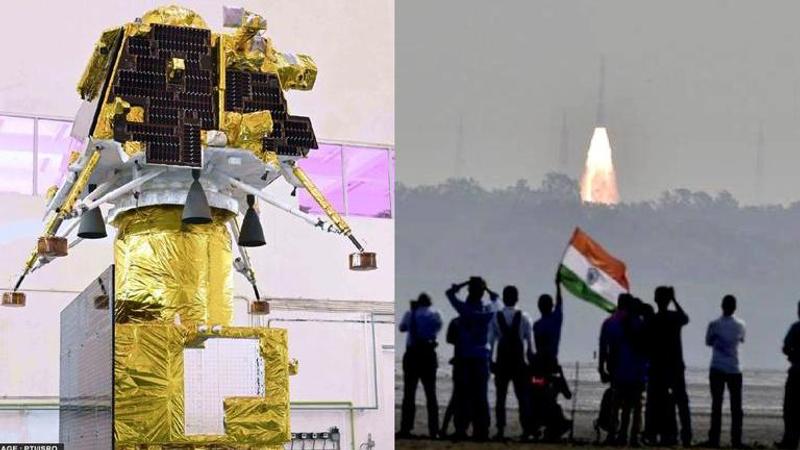Published 08:16 IST, July 14th 2023
Chandrayaan-3 will be 1st to land on Moon's South Pole; Here's why the region is important
ISRO's Chandrayaan-3, the third lunar exploration mission, is scheduled to make soft landing near Moon's south pole region on August 23.

On July 14, India embarked on a journey spanning more than a month, aiming to etch its name on the lunar surface by becoming the first country to achieve a soft landing on the Moon's enigmatic south pole. This groundbreaking endeavour, led by the Chandrayaan-3 mission, will demonstrate India's unwavering commitment to pushing the boundaries of space exploration and leaving an indelible legacy in the annals of human achievement.
But why this lunar region is so important?
Water Ice Reserves
Water ice has been discovered at both poles of the Moon, with the South Pole being of particular interest due to its larger expanse of continuous shadow and colder climate. This could potentially lead to a higher concentration of ice in this region. These deposits of ice are believed to have accumulated over billions of years as a result of the extremely low temperatures and limited exposure to sunlight in these areas. As a result, the Moon's South Pole presents an exciting opportunity for investigating potential water resources, which could play a vital role in future human exploration missions. The presence of water ice offers significant promise as a valuable resource, with possible applications including drinking water, fuel production, and supporting life support systems.
Exploration of Lunar History
The South Pole of the Moon holds a wealth of scientific insights. The limited sunlight in this region has helped maintain its surface in a relatively pristine state, acting as a repository of the Moon's historical record. Through examination of the geological characteristics, rock structures, and impact craters within this locale, researchers can glean valuable information about the Moon's origin, early development, and the extensive geological changes it has undergone across billions of years.
Solar System Evolution
The South Pole area offers an exceptional perspective for examining the progression of the Solar System. The polar craters on the Moon are believed to have captured substances from the initial phases of the Solar System, comprising comets and asteroids. This accumulation could potentially yield significant insights into the genesis and structure of these cosmic entities. Through careful examination of the samples and information garnered from the South Pole, scientists can enhance their comprehension of the overarching mechanisms that have influenced the formation and development of our Solar System.
According to NASA’s Chief Exploration Scientist at NASA Headquarters in Washington Jake Bleacher, lunar volatiles are likely trapped in permanently shadowed regions of the Moon, and "those volatiles have a story to tell us about the history of the solar system". “The ability to extract deep core samples and maintain their temperature and vacuum properties all the way back to research facilities on Earth could lead to powerful discoveries—not only about the volatiles but also about the history of our solar system," Bleacher said.
Potential for Future Lunar Bases
The existence of water ice in close proximity to the South Pole of the Moon renders it a compelling site for the establishment of forthcoming lunar bases. The water can be extracted and refined, furnishing vital supplies for extended expeditions and upholding human residency on the Moon. Furthermore, the landscape in this vicinity, characterised by areas of permanent shadow that mitigate drastic temperature fluctuations, presents the possibility of hosting habitats and sites for constructing essential infrastructure.
Astronomical Observations
The South Pole of the Moon holds significant benefits for astronomical observations. Its elevated position offers a favorable viewpoint for examining the depths of space, free from the disruption of Earth's atmospheric interference and light pollution. This advantageous positioning empowers astronomers to undertake a diverse array of investigations, encompassing the study of remote galaxies, analysis of cosmic microwave background radiation, and vigilant monitoring of transient celestial events.
Chandrayaan-3: India's race to Moon
Chandrayaan-3, the third lunar exploration mission,was launched on July 14 from Sriharikota as part of the fourth operational mission (M4) utilising the LVM3 launcher.
After completing several complex maneourves which included the crucial lander and propulsion module separations, Chandrayaan-3's Lander Module will soon initiate its descent, aiming for a soft landing in the south pole region of the Moon. This momentous event is anticipated to occur on August 23 as shared by scientists at the Indian Space Research Organisation (ISRO).
Significantly, the landing location chosen for the current mission bears a close resemblance to that of the previous Chandrayaan-2 endeavour. It is situated in proximity to the moon's south pole, specifically at a latitude of approximately 70 degrees.
As the countdown to the August 23 landing continues, the world watches in anticipation, eager to witness the culmination of ISRO's meticulous efforts and groundbreaking contributions to space exploration. In the event of a successful mission, India would join an exclusive group of nations that have achieved the feat of soft-landing a spacecraft on the Moon. This accomplishment has been previously attained by the United States, the former Soviet Union, and China, making India the fourth country to achieve this remarkable milestone. Moreover, India has the potential to secure an unprecedented achievement by becoming the first nation to land in the Moon's south pole region.
Updated 09:49 IST, August 20th 2023




